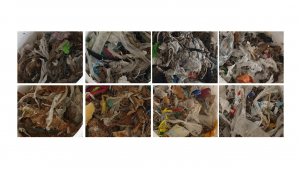Application Note: NIR Measurement of refuse derived fuels
Application Note: NIR Measurement of refuse derived fuels
1 .Intodruction
Near-Infrared (NIR) spectroscopy is a powerful analytical technique used in various industries for non-destructive and real-time monitoring of chemical and physical processes.
The sustainable disposal and use of waste is of great importance in times of scarce resources and environmental concerns. Refuse derived fuels (fig 1.) are an alternative to traditional fossil fuels and are playing an increasingly important role in energy recovery. NIR spectroscopy enables precise and efficient analysis of RDF materials, allowing their composition and energy content to be determined.
NIR enables the fast, non-destructive and comprehensive analysis of substitute fuels.

Fig. 1: Example of substitute fuels materials
2. Objective:
This application note presents the application of near-infrared (NIR) spectroscopy to measure refuse derived fuels (RDF). RDF is an important component in waste management and energy recovery. NIR spectroscopy offers a non-invasive and efficient method to characterize RDF to analyze its composition and energetic properties. This document explains the basics of NIR spectroscopy, the advantages of this technique for RDF measurement, typical applications and best practices.
3. NIR Spectroscopy Principles
Near-infrared (NIR) spectroscopy uses the near-infrared part of the electromagnetic spectrum, which lies between visible light and infrared radiation. This technique is based on the interaction of light with chemical bonds in molecules. Each material and molecule absorbs light in a unique way, producing a characteristic signal (=spectrum) (fig. 3). Analysis of these spectra enables substances in samples to be identified and quantified.
By measuring the absorption and reflection of NIR light, valuable information about the chemical composition and physical properties of the material can be obtained
NIR spectroscopy is particularly suitable for in-line and real-time monitoring due to its rapid measurement speed and non-destructive nature.
4. Benefits of NIR Measurement for refuse derived fuels:
- Speed and efficiency: NIR spectroscopy does not require extensive sample preparation and provides fast results in real time.
- Wide range of applications: The method can analyze various RDF materials including plastics, paper, wood, textiles and other combustible waste.
- Quality control: NIR spectroscopy enables continuous quality monitoring during RDF production.
- Environmentally friendly: Due to the non-invasive nature of NIR spectroscopy, there is no waste production during the analysis process.
- NIR spectroscopy can simultaneously analyze multiple components present in RDF, such as moisture content, calorific value, plastic content, and organic matter, providing comprehensive insights into the material.

Fig. 2: Materials can be measured with a process system (continuous measurement) (A) or sample-based system (B).

5. System Setup:
- Hardware: APOS NIR Spectrometer System BA-T or ModularNIR (fig. 2 system examples)
- Sample Preparation: Present materials with different properties to the system in their original state.
- Calibration: Acquire NIR spectra of the samples with different properties. Simultaneously, measure reference data for the respective parameter / application.
- Chemometric Analysis: Develop calibration models using chemometric techniques such as principal component analysis (PCA) and partial least squares regression (PLSR) to correlate the NIR spectra with the reference data.
- Validation: Validate the calibration models using independent samples to ensure accuracy and reliability.
